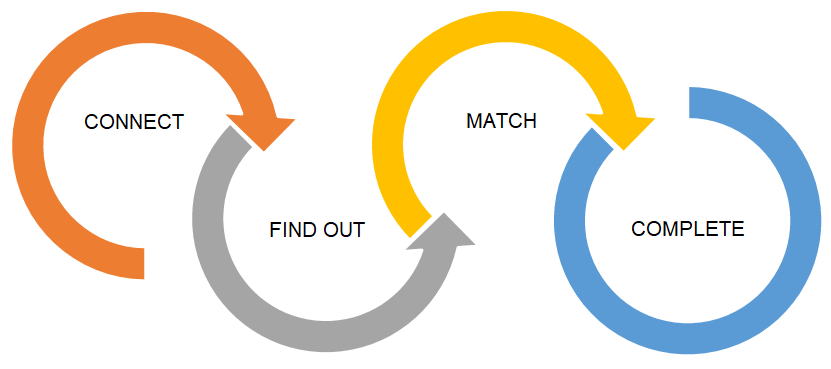What Are The Right Skills Needed To Achieve
A Consistently High Customer Experience and Improved Revenues in Retail Pharmacy?
We know that Retail revenues and margins are under threat by increased competition, both from within the industry and from supermarkets and others. So Retail need to give customers a reason to believe that they can uniquely add value. This value for the customer comes from their interaction with all staff, from the Pharmacist to the new store assistant. All of these people need four things to achieve this:

- A clearly understood customer handling process
- The right skills to use in different situations
- Adequate training and practice
- The right support from store supervisors and company management
The model for getting the customer experience right is called Conversational Selling™ and was developed by Prosell Learning Ltd. It was created by research done in a number of sectors, including Retail, Optical and Retail Banking. We asked potential customers under what conditions would they welcome suggestions to try new products and services? The answer, not surprisingly, was when the person dealing with them had taken time to understand both them and their issues, so that recommendations were valuable and needed. Conversational Selling™ was developed to achieve two specific things;
- Enhance the customer experience and drive customer loyalty
- Maximise the opportunity to both sell and up-sell
Conversational Selling™ research tells us that if you show a genuine and natural interest in the person you are talking to and accompany that with good skills, you will improve customer loyalty and sell more.
So before we get into the model, let’s spend a moment on ‘genuine and natural interest’. Most of us are aware that we communicate only 7% of our meaning by the words we use. 55% is body language and 38% is our tone, pitch and energy. So if you are to follow this process successfully, you should make sure you get the basics right:
- Avoid distractions, put down what you are doing and give the customer your full attention
- Use positive, open stance and welcoming gestures
- Look people in the eye and smile
- Sound enthusiastic and welcoming
Step One – Connect
- Greet your customer with eye contact, a friendly smile and open question to create a positive first impression
- Avoid ‘can I help you?’, or even worse, ‘are you OK?’. These are closed questions that invite rejection. ‘How can I help you?’ is fine, but try to be a bit more original, ‘What brings you into our store today?’ works well, as it can start a good conversation
- Acknowledge customers who are queuing, or have had to wait
- Show genuine interest and enthusiasm to help
- Use similar language and style to your customer
- Introduce yourself and get your customers’ name
Step Two – Find Out
- Give the customer your full attention, show interest and listen to what they say
- Ask about who the product is for, many purchases are for other members of the household
- Ask open questions to find out about the customer’s needs. Ask closed questions to confirm understanding
- Show concern with your questions – ‘How long has the condition existed?’ ‘What else have you tried?’ If buying for a child or parent, enquire about overall health
- Identify and gain customer’s interest in other products
Step Three – Match
- Discuss all product and service options in a knowledgeable manner. Avoid using product jargon
- Highlight and explain what the product/service will do and how it meets the customer's needs – ‘this will help with….’
- Offer any additional products that meet customer's needs
- Ask the customer if they have what they need and listen carefully to any concerns
- Always ask questions to clarify any concerns and confirm you have answered it
Step Four – Complete
- Process the transaction accurately
- Ask if customer has any other requirements
- Use customer’s name, thank the customer and conclude the transaction
- Personalise your goodbye by referring to the them or their family member and wishing a speedy resolution to the issue, if appropriate - a smiling and enthusiastic goodbye
Important Considerations for Effective Implementation
These four steps will give you a good framework for team members to understand the process and some skills guidelines for improving the customer experience. For this to be both effective and long term, a proper implementation process should be put in place.
The key to proper implementation is the right training. All staff in the store should participate in the training, irrespective of role, seniority or skill. It is important to create a sense of a team going on a journey together, not specific individuals needing help. The most critical part of the training given is practice. When developing skills (any skills, whether they be behavioural skills, technical skills, or even sporting skills), there in only one mechanism that truly delivers improvement and that is practice and feedback.
People should be allowed to practice a few times, to the point where they feel they can execute to a reasonable standard. If this does not happen then people fail to get to a point of competence and confidence. If someone doesn’t feel competent then their lack of confidence means they will avoid applying what they have learnt. This in turn leads to poor execution, a feeling of inadequate support and resentment for failure.
The final point is that real skill development takes place in the workplace, not the classroom. Our previous article on the role of Store Supervisors in the development process goes through exactly what is needed in the workplace and everyone should be clear that workplace coaching and support is the thing that drives a change in both skills and results.

Peter has a successful background in sales and sales management, as well as qualifications in behavioural science and sales training. He is the founder of Prosell Learning Ltd, A UK company and currently CEO of Prosell Australia. He specialises in improving sales and service operations by enhancing the effectiveness of staff and management. This is done through a combination of improving employee engagement (desire to do well) and management and employee skills (capability to achieve). He has worked within the Retail market and both the research and successful programs give him an intelligent insight into the challenges and solutions that drive genuine change in customer experience and improved results. These services have been delivered globally over a 35 year period.

